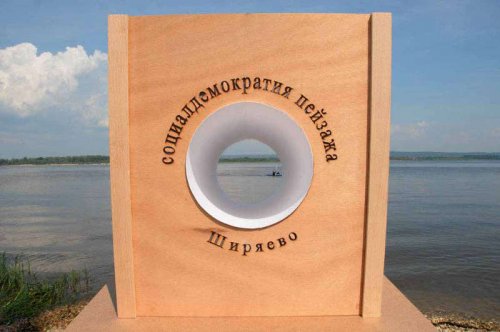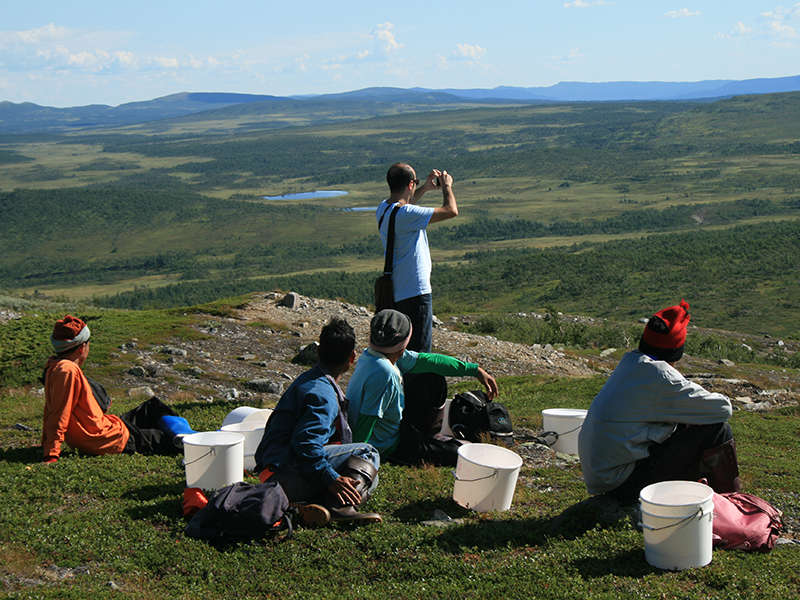
Accueil > Les rubriques > Images > Working for Zero
Working for Zero
The continuous rebirth of the art of Vito Pace
, et
Toutes les versions de cet article : [English] [italiano]
In its sixth publishing, Las Italias confronts with the evolution of the Vito Pace’s art, which is shaped by the conceptual art and by a continuous cancellation of the artistic object.
« The artwork, from the vase by the Greek craftsman, to the Vault of the Sistine Chapel, is always an exquisitely "relative" masterpiece. The artwork is never alone, it is always a comparison. Just to start, it’s at least a comparison with another artwork. An alone in the world work of art would not even be understood as a human production, but it would be regarded with reverence or horror, like some kind of magic, as a taboo, as a work created by God or by a sorcerer, not by a man. And we have already suffered too much from the myth of artists considered divine or the most divine in the world,1 instead of simply human1 ».
Written in the last century, these words are as relevant as ever when we consider them in relation to the specific direction of artistic research taken up by Vito Pace.
Born in Avigliano (in the province of Potenza) in 1966, Pace currently lives in Germany. His poetry goes, in the years after his academic training, towards a conceptual elaboration that starts from of the focus on the space to identify the process of realization and the perception of the artwork.
After he had abandoned the figurative and traditional sculpture, the first excursus in conceptual art is the performance Materialmente (Materially - Turin, 1991), in which two distinct moments in time are fixed through two tanks of water, in which the artist himself sink together with a picture of himself in the water. The production of the work - the action performed by the artist and its photographyc documentation - becomes the subject itself of the artwork.
The exhibition sets out the ’"happening" of the artwork, its realization in the world as a process (in this case a performative process) and not its condition of material object. In this sense we can say that the artist’s attention is directed to zeroing the poetic and emotional element of the work, in favour of an explicitation of the procedure necessary to achieve it.
The annihilation of the artwork as an object bearing an external meaning, or as a fetish or a symbol of the artist’s inner being or sensitivity, of his own condition as a creator, of his inspiration as divine and almost intangible element, takes place through the exposure of the concept that becomes work and of the process fitting for its realization.
Developing along this direction, the artworks by Pace become true through different techniques, making it impossible to establish an "aesthetics" continuity as his distinctive feature. In the development of his research the declared influences of the father of Conceptual Art, Joseph Kosuth, and of other members of the movement as the Japanese artist On Kawara and a progressive interest in the issues of space as an active part of the work and the perception of art are evident.
The process actually makes the work a manifestation of its concept, not only as a production basis for the artistic work but as its conceptual genesis on a mere intellectual level : what is produced (either a performance, an installation, a drawing, etc.) has the role of signifier and signified, it does not refer to external values, as there is no transcendence or inspiration in its being-in-the-world. Art becomes almost a scientific process, a laboratory research that finds – in the artwork- the disclosure of the found data.
But, by its own nature, this research knows no end, so each work becomes a part of an endless process that seeks - with each exposure, at each completed work realization - the "zero", that is the elimination of the work through its happening and the exposure of the process needed to produce it, to be able to start again with a new phase of the research.
A concept that seems due to the "active nihilism" of Friedrich Nietzsche, where the decay of values, the "Death of God," will be followed by a new rebirth.
Each work stands as a result of the above one, acquiring data - even in a physical meaning, through the notes the artist takes during the design of each work and that he reuses for subsequent work - as a starting point for the next stage of the research .
Which can lead to really technically different results which do not despise the new technologies, as in the case of Kontora Mir2 [The documentation is still available at the link : www.kontoramir.com], a project (Shiryaevo, 2001-2006) that was born as part of the second Shiryaevo Biennale of Arts and structured as a physical and virtual place for communication, discussion and artistic production, as well as a multimedia archive which has developed over the years in both its virtual part, through a website created and maintained by the Austrian artist and journalist Martin Krusche, both in its physical part, through workshops and seminars in European universities and academies.
http://www.youtube.com/watch?v=gy3UZans7F4
Kontora Mir
The two words that give the name to the project : Kontora (контора), office, and Mir (мир) world but also peace, gather its spirit : a common work place unrelated to a physical location, open and accessible from anywhere in the world, but also Pace’s office, wide-opened to collaboration with artists from everywhere.
http://www.youtube.com/watch?v=oiQcY4ea-7k
Kontora Mir
The artist’s drifting apart from the artwork could not be clearer : the object of art is not only non-existent, but it is collective, without an identity connotation attributed to a single author, but it is a steady process bringing together in a virtual place artists from all around the world.
The project comes to a conclusion in 2006 through the exhibition der Transfer ist aus (the transfer is finished - Milan, 2006), which brings together the works and the contributions of all the artists in one place and Pace himself expresses them through a performance, but with a very loud techno music undercurrent that makes futile any explanation, stating this way the impossibility of a real conclusion of an experience which began as a "place of peace" and in which collaborations, encounters and experiences were born.

- ein Hut und ein Kräuterlikör, disegno progettuale della villa, matita e acquerello su carta / project of the villa, pencil and watercolor on paper, 2004
Kontora Mir underlines another feature of Pace’s works : although they clearly belong to the world of art and therefore they are theoretically describable through its language, their complexity often makes inappropriate words such as installation, painting, drawing, etc..
The only correct way to speak about each of them is using the word "projects" rather than works, thus including finite elements that make them up and their conceptual origin.

- ein Hut und ein Kräuterlikör, ritratti/portraits, poliestere laccato nero / black laquered polyester, 2004
This is the case of ein Hut und ein Kräuterlikör (Stuttgart, 2002-2003), a project made up of several elements : the model of a villa with watercolor drawings of its plant and sections, three portraits of women and two columns with decorative inlays wood.

- ein Hut und ein Kräuterlikör, modello della villa in una teca di vetro, creta, legno, vetro/model of the villa in a glass case, clay, wood, glass, 2004
The narrative element suggested by the combination of the different parts of the work describes a story that really has never been told, a story that does not exist and is in fact the idea from which the work was created, the conceptual act of its genesis. Almost showing an "after" whose before is alluded but does not really.
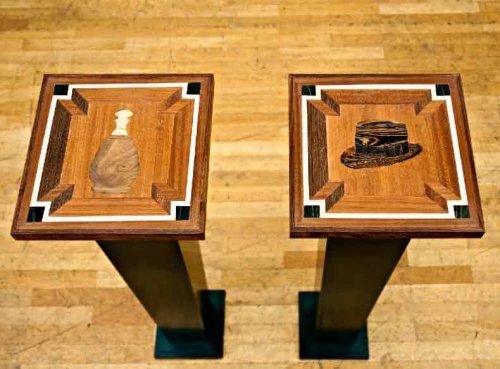
- ein Hut und ein Kräuterlikör, intarsio su colonne di legno / inlay on wooden columns, 2004
Every single element is realized with a precision and a formal neatness which makes it technically perfect, almost anonymous. Any indication of a signature or a track of the artist lack : each object dampens the work, they all put a distance between the work and the author, as a screen of a formal and technical precision pursued almost obsessively, looking for a way to explain the concept without any interference by the subject.
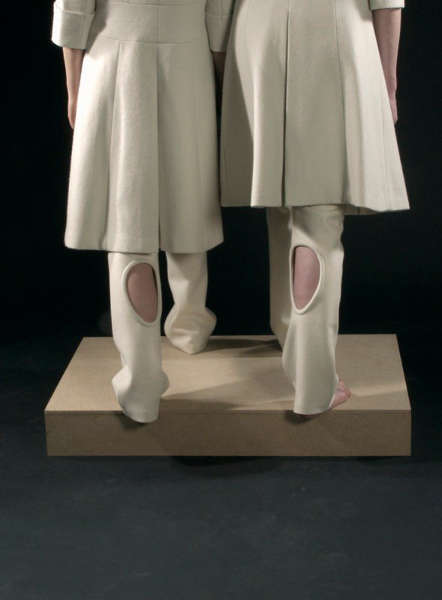
- Gastrocnemius, divise in feltro / uniform made of felt (part.), 2005
Next to the hermetic history of ein Hut und ein Kräuterlikör, Gastrocnemius (Stuttgart, 2004-2005) takes place another fictional narrative - not tied, this time, to the past but almost futuristic in its essence - composed of different objects : a room which was rebuilt in the exhibition space and documented by the plan and elevation drawings, some clothes with an oval incision on the muscle that gives its name to the artwork (the same Gastrocnemius which is located in the calf), a drawing in which you trace the "path" of the incidence of sunlight on the muscle itself.
http://www.youtube.com/watch?v=Y_YVPy0KS-M
Gastrocnemius
Even in this case, the artist seems to suggest a narrative element which is never explicit though ; as in some kind of puzzle, the elements are tangible and the solution can only result from a combination of them, and yet it is elusive. Furthermore, the deliberate anonymity of each component makes difficult to read the artwork in traditional terms.
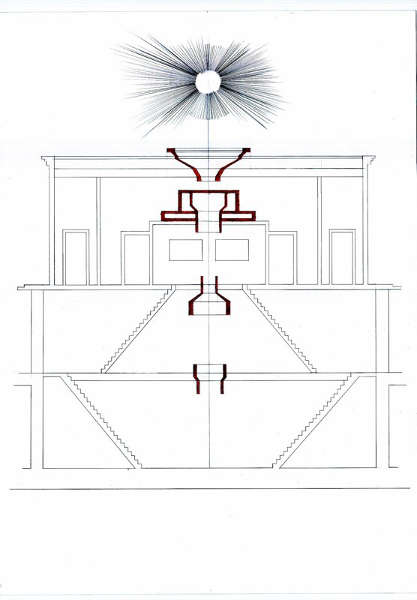
- Gastrocnemius, tavola della luce /light figure, matita e acquerello su carta / pencil and watercolor on paper, 2005
Ironically and provokingly, the artist pushes toward a different gaze : not being able to see "after" the work (what does it represent ?) he obliges you to see the "before" (what it is originated from). And to choose whether to participate in the subtle and intellectual play built by the works or to deny to confrontation.
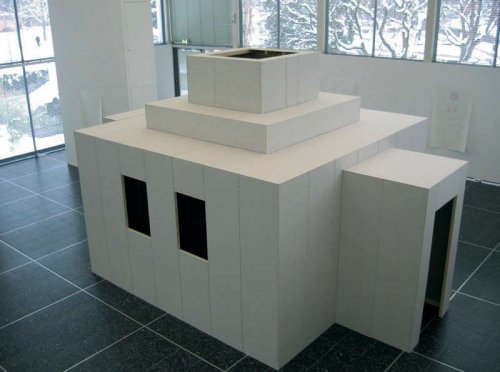
- Gastrocnemius - Haus, costruzione con pannelli di cartongesso / building made of plasterboard, 2005
A reverse process (not a work that originated in a hypothetical story but the creation of a story through visual art) emerges in the installation to Emma Ricklud, which was born during a residency at the Ricklundgården (Saxnäs 2009 ), or the house where the Swedish painter Folke Ricklund and his wife Emma lived, in which since the ’60s a foundation and an international cultural center takes place.
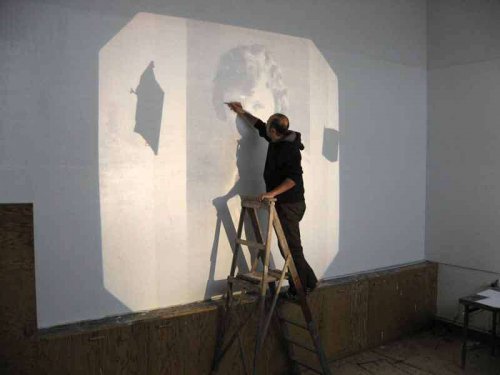
- to Emma Richlund, 2008
The work arises from Emma Ricklund’s storyx who, according to some sources, was a "clandestine" painter : she used to hide her works because she believed them not to be up to those of her husband, who were known in Sweden as "the painter of the mountain" at the time.
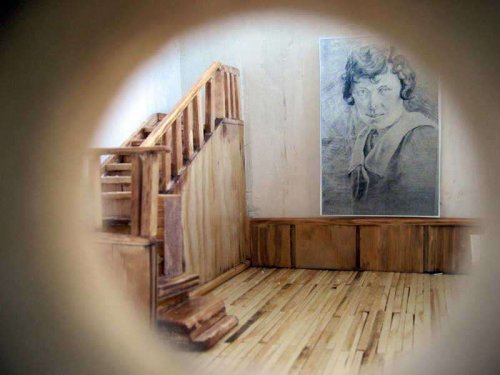
- to Emma Richlund, riproduzione in miniatura dello spazio esterno/a miniature painting of the external space, 2008
In the work dedicated to her, Pace staged a tribute to her memory through different steps : in the beginning he drew on the wall of the studio a portrait of her (the same that Folke would have used during his life in Saxnäs), then he took a picture of it and put the shot into a miniature reconstruction of the study, that is visible only through a small hole in the wooden box that houses it.
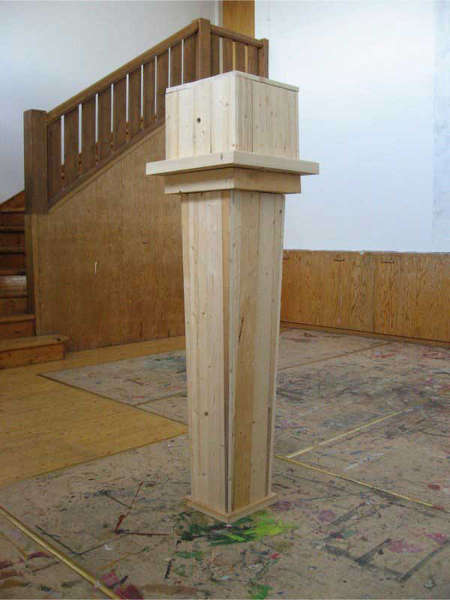
- to Emma Richlund, colonna in legno e riproduzione in miniatura dello spazio esterno/column in wood and a miniature painting of the external space, 2008
This way, the position of artist-in-the-studio is symbolically returned to Emma Ricklund, a new story is built for her, a story that takes shape in the installation that bears her name.

- Post Scriptum, cornice in marmo/marble frame, 2008
Another passage from narrative to memory takes place through Post Scriptum a project in which the research on his own origins leads Pace along two directions : a private one, linked to an artist who was his compatriot, the other one is projected outwards that reverberates in the environment and the Lucan landscape.

- Post Scriptum, fotografia/photograph, 2008
For the first issue, he uses the figure of Vincenzo Claps (1913-1975) an exponent of Lucanian neo-realism of the ’40s and the author of the painting Ragazzo delle elementary (Scholar boy, 1948) that inspired Pace was to some kind of self-analysis.

- Post Scriptum, dipinto / painting, 2008
The study on the painting goes through its reproduction and the creation of the clothes of the student : the portrait becomes a symbol of a time stage that is at the same time in the past -as it belongs to a historical period now over - and present - through the revision made by the artist in an endless game of mirrors.
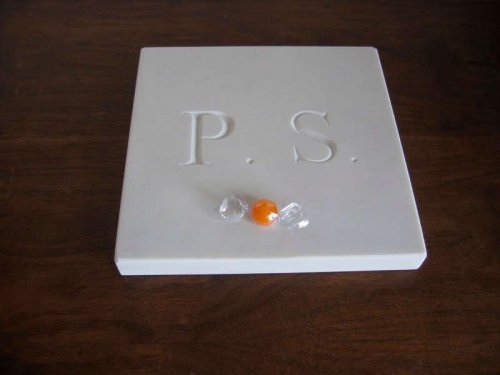
- Post Scriptum, marmo, caramella/marble, candy, 2008
Besides to it, a marble with the inscription P.S. Post Scriptum, which can also be read as Post Mortem, or as an evocation of something or someone that there is not (or no longer), and an altar that holds an empty frame, inspired by a tombstone : but that, rather than being assigned to contain a single photograph of the deceased, it is designated to "capture" the landscape, as some photos taken through the frame show.
The dimension of the external world combines the personal one, dialing the past and the present in the landscape that belongs to the land of origin of the artist.

- Post Scriptum, abiti, clothes, 2008
Perception and vision are presented as predominant investigative tools in the following Pace’s projects, as in Svenska Landskap (Gleisdorf, Austria 2009) in which two elements traditionally belonging to art -a photograph of a landscape and its pictorial reproduction - are exhibited in an art gallery where nobody cannot enter.
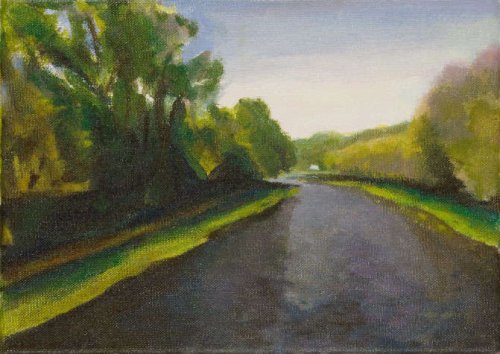
- Svenska Landskap, dipinto ad olio/oil painting, 2009
So a distance fruition, available through a glass is imposed to the photograph and the painting, placed in an inaccessible place ; it forces the viewer to reflect on space : the one where he is confined, the one in which the works are physically exposed and finally his mind, where his ideas about the exhibited works take shape. The subject of the work is therefore not the landscape but the idea of space.
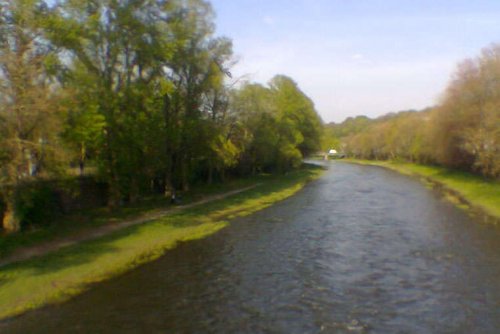
- Svenska Landskap, fotografia/photograph, 2009
On the other hand, in spite of what the title says, it was not realized in Sweden, but in Germany. Then a misrepresentation of the elements that make up the work is obvious, as if to get closer to abstraction - (in the etymological sense of the term, that is essence, or idea from which it arises) - the work should move away from the artist and from the contingency of the representation of a real element and open a reflection on aestethics, on construction and reproduction of reality and of art.

- Svenska Landscap, veduta della mostra / exhibition view, 2009
This reflection returns in Betrachtungsapparat (Berlin - Pforzheim, 2010), an art project that was inspired by the most congenial place for an artist : his studio, and it is divided into two phases and in two different places. The starting point is L’atelier du peintre by Goustave Courbet a work in which the artist depicts himself in his studio while he painted ; it is assumed as a link with the traditional view of the artist and of his way to create to subvert the sense, making a reversal of both coordinates.
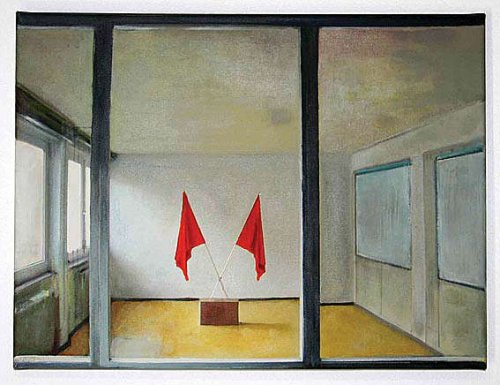
- Betrachtungsapparat - Atelier Erasmusstrasse, acrilico su tela / acrylic on canvas, 2010
The first part of the project, Atelier Erasmus Strasse, has as a scenario the atelier where Pace operates normally. He empties it, removing all the elements of the "artistic making" (tools, materials, artifacts, models, etc.), reducing the space to its zero grade.
In this vacuum, the artist inserts two red flags that have nothing to do with the art itself, but they are two simple objects, whose connotation does not provide guidance (representing a party ? A Company ? A State ?) .
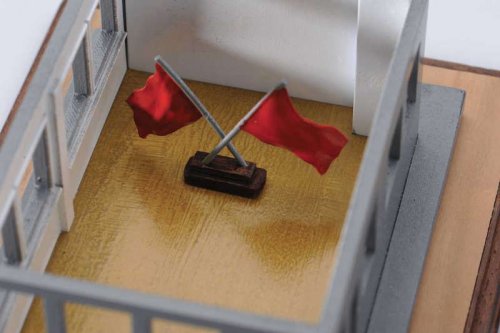
- Betrachtungsapparat - Atelier Erasmusstrasse, modello in scala, resine epossidiche, legno, vernici senza solventi colore / scaled model, epoxy resins, wood, color solvent-free coatings, 2010
The study, in its new role, is depicted from the outside. The painting is inserted into a miniature of the atelier, as a representation of the process that occurred elsewhere. So the creative act (the painting) is made outside of the space designed to (the study), confirming the innate ambivalence of the process of realization of the work.
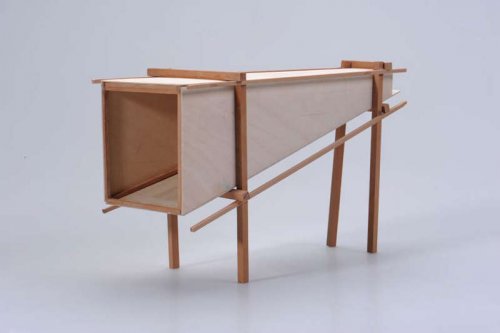
- Betrachtungsapparat - Atelier Berlin, camera obscura, modello in scala /scaled model, 2010
In the second phase, Atelier Berlin, that was made during a residence of the artist in Berlin, the object of the representation is the space outside of the new atelier, which Pace observes and reproduces through an "apparatus for the vision", or a sort of camera obscura built by himself, which, when it is placed by the window, provides him a delimited framing of the area outside the atelier.
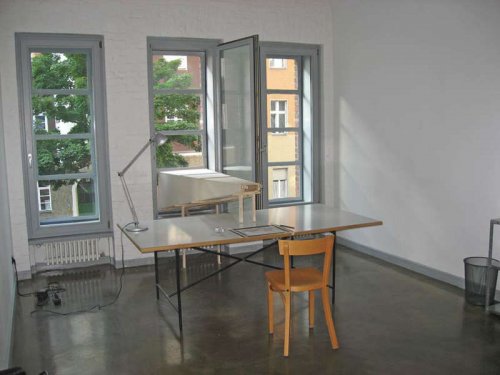
- Betrachtungsapparat -Atelier Berlin, camera obscura nello studio / camera obscura in the atelier, 2010
Later, Pace points the same device to Treptower Park in Berlin, maintaining the same angle that it had in the studio, and draws the park.

- Betrachtungsapparat - Atelier Berlin, disegno (vista dallo studio) / drawing (view from the atelier), 2010
The re-construction of this landscape refers to the creative process of Post Scriptum, but the emptiness of the photo frame is replaced by an apparatus for the vision that supports a process as old as the drawing en plein air.
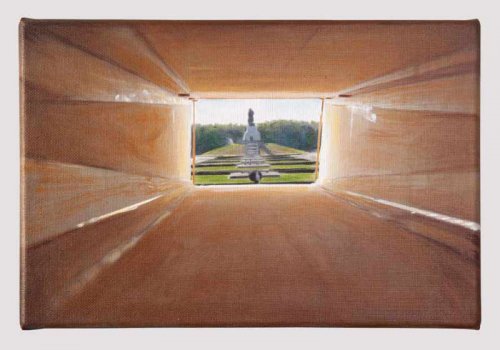
- Betrachtungsapparat - Atelier Berlin, Treptowerpark, acrilico su tela / Trptower Pak, acrilyc on canva, 2010
The works belonging to Betrachtungsapparat were sent to Russia for the event Street Museum - Museum as Street together with a new project dedicated to ’"Order of the arts", which investigates the interaction between an artistic and aesthetic act and the human and social dynamics of urban contexts.
It consists of two marble road names plates : on the first there are the words "the order of the arts" engraved in Latin (Artium Ratio), and then it was donated to the city of Ullyanovsk ; the other one with the same phrase translated into Russian (Порядок вискусстве) was delivered to the small town of Avigliano, place of origin of the artist.
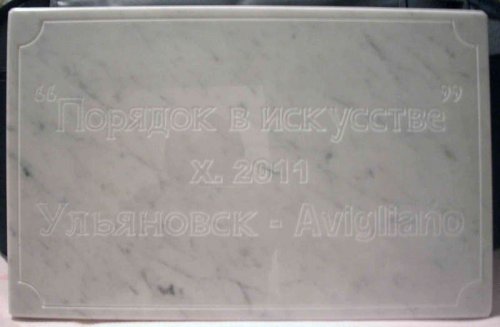
- L’ordine delle Arti, marmo / marble, 2011
The founding principle of the work lies in the deliberation of making art, as it is summarized by the expression "the order of the arts" understood as a philosophical and aesthetic formula which suggests on the one hand, the value of art as an aesthetic "canon" and a "rule" for the use of space, and on the other is configured as a key element for the functional and aesthetic perception of the urban space as an "order" for the social plurality. As a law engraved on the marble that shows the order of the arts as the art of social order.
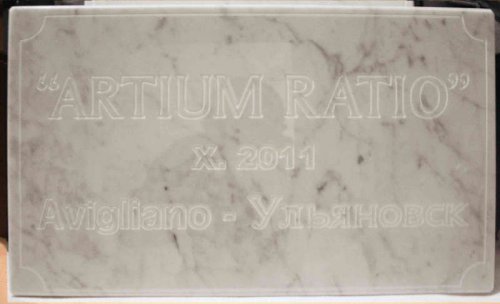
- L’ordine delle Arti, marmo / marble, 2011
The public, social and political space represents the most recent research direction of the artist, as shown by the work Sozialdemotratie der landschaft (Social Democracy of the landscape, Shyriaevo 2013).
While this project is an evolution and deepening of the researches on the perception of space conducted by Svenska Landskap and Betrachtungsapparat, on the other hand it focuses on the utopian strain of the society towards an unattainable equality and democracy.
The project consists of a device through which you can observe the "social democratic landscape". Along the line of the paradox where the projects of Pace often move, this device is actually a kind of sophisticated frame that focuses a portion of the landscape on a soundtrack - created by Igor Vaganov3 – composed by music, sounds collage and speeches fragments.
A provocation which seems to suggest that the only form of social democracy that can succeed is that of the landscape surrounding the observer (in fact, the device does nothing but to frame what is in front of it) and it opens to the paradox in order to force to the reflection on the nowadays social and political situation.
A connection to the present day establishes the artist as belonging to the contemporary world, without needing him to lend himself as the representative of a movement or a political organization. According to Vito Pace, the artist’s task is not to find answers, but to keep asking questions, through a reflection on everyday philosophical, cultural, social and political aspects of his own time.
Voir en ligne : the official website of Vito Pace
1 R. Longhi, Proposte per una critica d’arte, in Paragone Arte, 1950 page17.
2 The documentation is still available at the link : www.kontoramir.com
3 Igor Vaganov, Social-democratic landscape in Russiasoundtrack, polyphonic music and sounds collage for a bullhorn. You can listen to it at he link :
http://www.svenskalandskap.com/wp-content/uploads/2013/09/igor_vaganov_social_democratic_landscape_in_russia.mp3
Aknowledgments :
Antonella Opera for supervision of English translation
